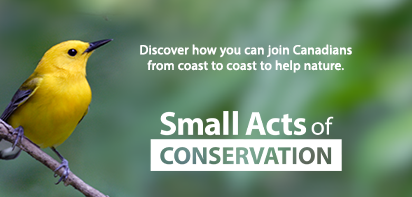Apple growers make a difference at Covey Hill
Landscaping for biodiversity ... and apples
The salamanders and birds of the Haut-Saint-Laurent now have farmers as allies. Thanks to novel tools, fruit growers are now able to manage their land for biodiversity and their own production.
Covey Hill is home to three species of at-risk salamander, including Quebec's only occurrence of the Allegheny mountain dusky salamander. Spring salamanders and northern dusky salamanders also frequent Covey Hill's streams. The area is also home to species of at-risk birds, such as bobolink and eastern meadowlark. The region is of particular importance, and the Nature Conservancy of Canada (NCC) is working with growers to reduce the impact of apple production on these endangered species.
NCC partnered with the Ministère de l'Agriculture, des Pêcheries et de l'Alimentation (MAPAQ) and agronomists working with Covey Hill apple growers to create a tool box, which provides options for implementing agri-environmental practices in orchards. This includes choices such as windbreaks, flower islands, riparian buffer strips, and bird nesting boxes and bat dormitories.
A promotion tool, Biodiversité aux champs (French only), is also presented to interested parties. The tool recognizes the actions taken by apple growers to promote biodiversity, encourages other growers to adopt more environmentally friendly practices, and raises participating companies’ profiles.
Greater biodiversity in the orchard attracts insects that predate and parasitize pests, as well as insectivores such as golden-winged warbler, a bird species threatened in Quebec. Insectivors contribute to the biological control of crop pests and reduce the need for pesticides. Pollinators are also attracted to the area, benefiting the apple trees. All of the proposed improvements are designed to make the orchard more resilient to disturbances such as pests and climate change.
NCC’s ultimate aim is to perpetuate its efforts by putting in place conservation measures in perpetuity that, first and foremost, benefit biodiversity, but also agriculture. NCC can offer personalized conservation tools to producers who wish to protect the natural environments on their land.
Highlights
- NCC has recruited five apple growers to the project. To date, three have implemented measures in their orchards to promote nine species at risk. In 2023, Les Vergers du Château Albert received gold-level certification under the Biodiversité aux champs program.
- Brook salamanders, including the three species found at Covey Hill, have no lungs and breathe through their skin. They require cool, unpolluted, moist habitat to survive. This species is particularly sensitive to disturbances in the water and is a good indicator of the natural environment’s health.
- Covey Hill is also home to several other species at risk, including aerial insectivores (little brown bat, eastern whip-poor-will), four-toed salamander and eastern milk snake.
Quotes
"Thanks to our collaboration with Covey Hill apple growers, we are creating more resilient and environmentally friendly orchards. We're proud to be working together to maintain a favorable environment for vulnerable species."
- Chantal Cloutier, Project Manager, Nature Conservancy of Canada
“The apple orchards of Quebec’s Haut-Saint-Laurent region have become essential partners in the protection of salamanders and field birds. Thanks to innovative tools developed by the Nature Conservancy of Canada, with support from the Priority Places for Species at Risk initiative, these fruit growers can now enrich their land in a way that benefits both biodiversity and agricultural production. This initiative, part of the Pan-Canadian Approach to Transforming Species at Risk Conservation in Canada, is advancing the planning and implementation of conservation measures, as well as engaging partners and stakeholders.”
- The Honourable Steven Guilbeault, Minister of Environment and Climate Change
Acknowledgements
The Nature Conservancy of Canada thanks the Government of Canada, through the Canada Nature Fund, the Government of Quebec, through the Accélérer la conservation dans le sud du Québec (ACSQ) and the Fondation de la faune du Québec, through the Faune en danger program. NCC would also like to thank Vergers du Château Albert, Vergers Leahy, Vergers Écologiques Philion and Vergers Pomibec inc. Finally, we would like to acknowledge the implication of the MAPAQ, agronomists Lauréline Boyer, Andréa Schroeder and Vicky Filion, Pleine Terre, Gestrie-Sol and Club Producteurs Sud-Ouest (CPSO).
About
The Nature Conservancy of Canada (NCC) is the country’s unifying force for nature. NCC seeks solutions to the twin crises of rapid biodiversity loss and climate change through large-scale, permanent land conservation. As a trusted partner, NCC works with people, communities, businesses and government to protect and care for our country’s natural areas. Since 1962, NCC has brought Canadians together to conserve and restore more than 15 million hectares. In Quebec, NCC partners regularly with Conservation de la nature Québec (CNQ), a non-profit organization that is distinct from NCC, to conserve Quebec’s richest natural areas. Together, the two organizations have conserved more than 55,000 hectares of natural areas in the province. To learn more, visit natureconservancy.ca.
The Canada Nature Fund enables significant, targeted investments and enhanced partnerships to drive improved protection and recovery for a large number of species at risk throughout the country, as agreed to in the Pan-Canadian Approach to Transforming Species at Risk Conservation in Canada. Priority Places for Species at Risk are areas of high biodiversity value that are seen as a distinct place with a common ecological theme by the people who live and work there. These places have significant biodiversity, concentrations of species at risk, and opportunities to advance conservation efforts. Focusing on these areas allows us to conserve and restore habitats that benefit many species at once.
The mission of the Fondation de la faune du Québec is to promote the conservation and enhancement of wildlife and its habitats. Thanks to the contributions of over a million Quebec hunters, anglers and trappers, thousands of donors and numerous private companies, the Foundation has been supporting over 2,000 organizations throughout Quebec since 1987.
The Accélérer la conservation dans le sud du Québec (ACSQ) project is a co-funding agreement between the gouvernement du Québec and the Nature Conservancy of Canada (NCC), benefiting Quebec conservation organizations. The project aims to protect and conserve natural habitats of ecological interest, notably through the acquisition of private land, for protected and conserved areas and the establishment of ecological corridors. Through this, the ACSQ will promote the development and sound management of the network of protected areas on private land, as well as public access to nature. The gouvernement du Québec invested $144 million in the ACSQ over five years; this must be matched by NCC and its partners with other funds not provided by the gouvernement du Québec.
The MAPAQ is responsible for the bio-food sector, which covers all activities related to agriculture, commercial fishing and aquaculture, food processing and the food trade. This sector also includes food services for the hotel and restaurant trade, as well as private and public institutional markets. It monitors the entire food chain to protect public health and improve animal health and welfare.
Gestrie-Sol is an agri-environmental consulting club offering a multitude of services that have developed expertise in biodiversity. Above all, they are a source of professional consulting services aimed at improving their customers' environmental and economic performance.
The Club Producteurs Sud-Ouest is an association of some 20 growers offering advisory services mainly in the field of apple growing.
Pleine Terre is a multi-disciplinary team that combines expertise in the fields of agriculture, agri-environmental and rural engineering, biology, soil science, and water and land management. It has the capacity to manage environmental issues to ensure that projects are carried out with a view to sustainability.
Learn More
Follow us on on X (formerly Twitter): x.com/NCC_CNC | x.com/NCC_CNCMedia
Find us on Facebook
- 30 -




